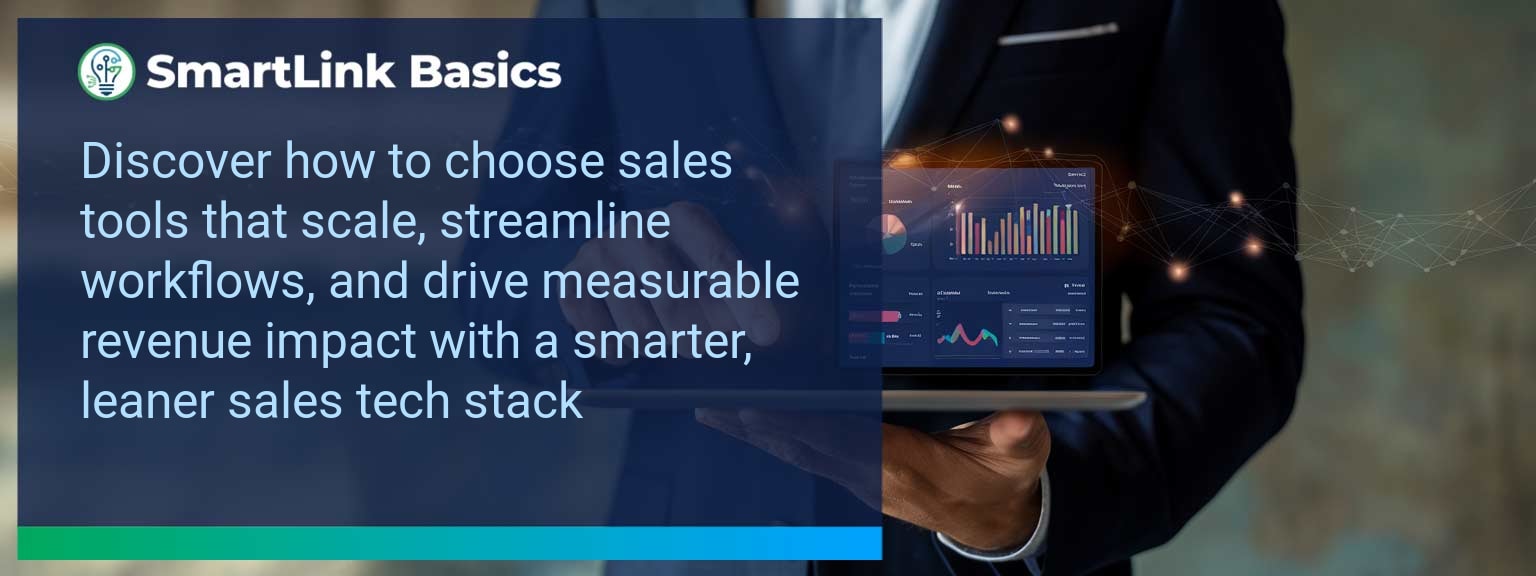Too many sales leaders are drowning in bloated technology stacks that drain resources instead of accelerating performance. According to Gartner, B2B sales teams now use more than ten tools a day, yet only 30% of reps believe those tools truly help them sell. At SmartLink Basics, we see this as a critical leadership challenge. Having the right sales tools that scale can determine whether your team accelerates pipeline or gets buried under inefficiency. This guide shows you how to architect a lean, modern sales tech stack that aligns with your goals, scales intelligently, and unlocks revenue growth. You’ll discover frameworks to evaluate, optimize, and measure tools with precision—enabling smarter sales enablement and long-term ROI.
- Anchor your stack strategy to revenue priorities, not tools.
- Audit current systems to cut redundancy and reclaim ROI.
- Adopt a core + modular framework for scalability.
- Bake enablement workflows into every implementation plan.
- Track impact with metrics that tie tools to pipeline outcomes.
The Pitfalls Of Bloated Tech Stacks
Sales organizations often chase the latest apps without a clear roadmap. This leads to overlapping subscriptions, underused platforms, and poor CRM optimization. The result is more admin time, slower cycles, and frustrated reps who feel tools are barriers rather than accelerators. Growth stalls when stacks grow without coordination.
A practical example: one SaaS firm found four separate prospecting tools in use, each with low adoption. After consolidating around a single workflow integration platform, the sales team reduced costs by 30% and shortened rep onboarding by two weeks. The lesson is clear: simplicity enables focus, and focus drives performance.
Strategic Steps To Build A Winning Sales Stack
To unlock true scalability, leaders need to design sales tech stacks with intention. Begin by defining your ICP, account segmentation, and GTM priorities. These strategic anchors prevent random tool purchases and help your team focus on what matters most: driving predictable pipeline.
Pipeline architecture is the second step. Map tools to buyer stages from awareness to expansion. For instance, pairing a CRM system with an engagement platform ensures continuity across the customer journey. Then build messaging and plays directly inside your sales automation tools. This ensures your stack reinforces process discipline instead of fragmenting it.
Finally, establish your operating cadence. Decide how performance analytics will be reviewed: weekly team dashboards, monthly ROI reports, and quarterly rationalization audits. This transforms tools from passive apps into managed systems of revenue operations.
Measurable Impact On Sales Productivity And ROI
When sales leaders treat technology as a growth system, the results are measurable. For example, one security software company embedded enablement into their sales engagement tool, reducing rep ramp time by 30%. Another mid-market firm redesigned with a core+modular framework, unlocking $500K in annual savings.
The key is disciplined measurement. Tagging deals in the CRM, reviewing adoption dashboards, and tying usage data to pipeline velocity ensures accountability. Without metrics, even the best stack becomes guesswork. With them, every investment is viewed through the lens of impact and ROI.
| Category | Metric | Definition | Target |
|---|---|---|---|
| Leading | Tool Adoption Rate | % of reps actively using new tools weekly | 85%+ |
| Leading | Data Capture Accuracy | % of CRM fields completed correctly post-integration | 95%+ |
| Lagging | Pipeline Velocity | Average days from opportunity creation to close | Reduce by 15% |
| Lagging | Revenue Influence | % of closed-won deals touched by tool workflows | 70%+ |
| Quality | Rep Sentiment Score | Survey-based feedback on tool usefulness | 8/10 average |
| Quality | Integration Health | % of workflows running without data sync errors | 98%+ |
Get the 90-day plan, coaching rubric, and dashboard template to operationalize AI in your enablement program.
Smart Leaders Build Smarter Revenue Systems
Scaled sales performance requires more than tool selection. It demands strategy, alignment, and ongoing measurement. By auditing your current tech, structuring a core+modular system, and embedding enablement, you ensure every tool adds value. For deeper insights, explore AI-driven sales enablement resources from SmartLink Basics and start transforming your stack into a true growth engine.









